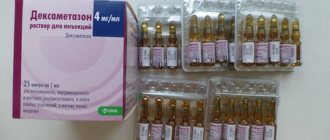Effect on the body
The mechanism of action of diazepam is its stimulation of benzodiazepine receptors with simultaneous activation of GABA receptors and inhibition in synapses that regulate the emotional sphere, including the thalamus, hypothalamus, reticular formation and limbic system of the brain. Thanks to this effect, when using Diazepam, you can get several effects at once. Its ability to regulate the central nervous system gives the following results:
- Soothing. The sedative effect is to relieve anxiety and restlessness, reduce the body’s reactivity to external stimuli, and drowsiness. When using the drug in maximum quantities, inability to concentrate and absent-mindedness may occur. Overdose causes amnesia.
- Anxiolytic. A person’s anxiety level decreases, fears and tension go away.
- Hypnotic. Inhibiting arousal in the brain and eliminating excessive arousal helps a person normalize sleep and ensures falling asleep quickly.
- Anticonvulsant. The muscle relaxant effect of the substance blocks the conduction of impulses along interneurons located in the spinal cord. This allows you to stop seizures and reduce limb tremors.
The drug helps increase the pain threshold, reduces the need for peripheral tissues for oxygen, and eliminates syndromes caused by activation of the autonomic nervous system. All the main effects of Diazepam have a beneficial effect during the treatment of chronic alcoholism. It makes it much easier to survive the signs of withdrawal, stopping most of its symptoms. The medicine helps eliminate hand tremors, psychomotor agitation, anxiety, unmotivated aggression, convulsive syndrome, hallucinosis and reduces the severity of signs of alcoholic delirium.
Pharmacological properties of the drug Diazepam
A tranquilizer of the benzodiazepine group, it has anxiolytic, sedative, muscle relaxant and anticonvulsant effects, potentiating the effects of the GABAergic system by stimulating the central action of GABA, the main inhibitory neurotransmitter of the brain. Benzodiazepine derivatives act in the same way as benzodiazepine receptor agonists, which form a component of a functional supramolecular unit known as the benzodiazepine-GABA-chlorionophore receptor complex located on the neuronal membrane. Due to the selective stimulating effect on GABA receptors in the ascending reticular formation of the brain stem, it reduces excitation of the cortex, limbic region, thalamus and hypothalamus and has an anxiolytic and sedative-hypnotic effect. Due to its inhibitory effect on polysynaptic spinal reflexes, it has a muscle relaxant effect. Diazepam is quickly and completely absorbed from the digestive tract; the maximum concentration in blood plasma is achieved 30–90 minutes after oral administration. After an intramuscular injection, complete absorption also occurs, although this process is not always faster than after oral administration. The elimination curve of diazepam is biphasic: an initial phase of rapid and widespread distribution with a half-life of up to 3 hours is followed by a long terminal elimination phase (with a half-life of up to 48 hours). Diazepam is metabolized into the pharmacologically active nordiazepam (half-life - 96 hours), hydroxydiazepam and oxazepam. Diazepam and its metabolites are bound to plasma proteins (diazepam 98%); excreted mainly in the urine (about 70%) in the form of free or conjugated metabolites. The half-life may increase in newborns, elderly and senile patients and in patients with liver or kidney disease; however, it may take a longer time to achieve equilibrium concentration in the blood plasma. Diazepam and its metabolites pass through the blood-brain barrier and the placental barrier. They are also detected in breast milk at concentrations approximately 1/10 of the concentration in maternal plasma.
Indications for use of "Diazepam"
To get the desired result, you need to take the drug as prescribed. You should not use the drug without the advice of a doctor, since Diazepam causes many negative effects and leads to addiction.
Recommended Dosages
According to the instructions, the dosage of Diazepam for an adult is from 4 to 15 mg per day. It is necessary to take the drug by dividing the total dosage into two doses. Parenteral administration is 10-20 mg, and its frequency is determined by a specialist. Withdrawal syndrome is relieved by using a tranquilizer 10 mg up to 4 times a day. After which it is recommended to switch to a maintenance dose of 5 mg 2-4 times a day.
Contraindications
The drug has many side effects. And in some cases its use is contraindicated. "Diazepam" is not recommended for treatment in the following situations and diseases:
- glaucoma without aqueous outflow (angle-closure)
- functional failure of the kidneys and liver
- respiratory disorders
- muscular asthenia
- sudden drop in blood pressure, shock
- loss of consciousness
- organic changes in the brain
- drug overdose and alcohol poisoning
- treatment with drugs that have a depressant effect on the nervous system
- intolerance to the active substance and additional components
- pregnancy and breastfeeding
Side effects
Before starting treatment, you should carefully read the instructions. Some patients may experience side effects when using Diazepam:
- severe drowsiness
- weakness, lack of activity
- myasthenia gravis
- bronchospasm
- drop in blood pressure
- hiccups (with rapid intravenous administration)
- dry mouth
- breathing disorder
- decreased potency in men (disappears after discontinuation of the drug)
- paradoxical arousal
- nausea, vomiting and intestinal upset
- hyperprolactinemia
If, after taking or administering the drug, negative symptoms are observed or intolerance is detected, you should immediately consult a doctor. It may be necessary to reduce the dose or reconsider treatment in favor of another tranquilizer.
Interaction with alcohol and other drugs
Treatment should never be combined with alcohol. If you take strong drinks at the same time as Diazepam, the likelihood of developing an adverse reaction increases significantly even with a minimum dosage. Intoxication occurs faster, pronounced inhibition of brain structures leads to loss of consciousness and a life-threatening condition.
When using the drug, it is necessary to take into account the peculiarities of its interaction with other drugs. Otherwise, overdose symptoms and negative reactions may be increased or sharply decreased:
- the likelihood of side effects increases with the use of anticoagulants and beta blockers
- the use of sleeping pills increases drowsiness and lethargy
- the use of muscle relaxants can lead to severe weakness and potentiation of the effect of the tranquilizer
- joint treatment with antipsychotics increases their effectiveness
- Taking antidepressants neutralizes the effects of anxiolytics
Drug interactions Diazepam
Concomitant use of cimetidine (but not ranitidine) reduces the clearance of diazepam. There are also reports that diazepam interferes with the metabolism of phenytoin. There is no data on interaction with antidiabetic agents, anticoagulants and diuretics. In the case of combined use of diazepam and neuroleptics, tranquilizers, antidepressants, hypnotics, anticonvulsants, analgesics and anesthetics, mutual potentiation of effects is possible. Diazepam in the form of an injection solution cannot be mixed in the same volume with other solutions, as this may lead to precipitation of the active substance.
Application in the treatment of alcoholism
Indications for the use of Diazepam in the treatment of chronic alcoholism are the development of delirium and severe withdrawal syndrome. The person’s condition at this moment becomes severe, as there is a failure in the central regulatory system responsible for mood and emotions. Severe stimulation of brain structures is accompanied by life-threatening symptoms.
The mechanism of action of Diazepam is to reduce the excitability of nerve cells. This helps to relieve all the main symptoms and eliminates:
- anxiety
- psychomotor agitation
- sleep disturbance
The drug helps increase the pain threshold, reduces the need for peripheral tissues for oxygen, and eliminates syndromes caused by activation of the autonomic nervous system. All the main effects of Diazepam have a beneficial effect during the treatment of chronic alcoholism. It makes it much easier to survive the signs of withdrawal, stopping most of its symptoms. The medicine eliminates hand tremors, unmotivated aggression, convulsive syndrome, and hallucinosis.
For acute psychotic manifestations in an alcoholic during the withdrawal period, the drug is best administered intravenously or intramuscularly. This allows you to quickly fix the problem. At home, it is recommended to use rectal administration. Oral administration is not always appropriate, especially when nausea and vomiting occur.
Side effects of the drug Diazepam
Most often - lethargy, drowsiness and muscle weakness (usually depends on the dose); rarely - confusion, constipation, depression, dullness of emotions, decreased attention, diplopia, dysarthria, headache, hypotension, urinary incontinence, increased or decreased libido, nausea, xerostomia or increased salivation, skin rash, slurred speech, tremor, delay urine, headache, dizziness, blurred vision; very rarely - increased activity of transaminases and alkaline phosphatase, as well as jaundice. Paradoxical reactions such as acute agitation, anxiety, sleep disturbances and hallucinations have been described; If they occur, diazepam should be discontinued. With parenteral use - thrombosis and thrombophlebitis, local irritation (especially after rapid intravenous administration). Diazepam solution should not be injected into very small veins; It is unacceptable to administer intravenously and get the solution into adjacent tissues. IM injections may be accompanied by pain and erythema.
special instructions
An IV solution of diazepam should be injected slowly into a large vein over at least 1 minute for every 5 mg (1 ml) of the drug. It is not recommended to carry out continuous intravenous infusions - sedimentation and adsorption of the drug by polyvinyl chloride materials of infusion balloons and tubes is possible. During treatment, patients are strictly prohibited from drinking ethanol. In case of renal/liver failure and long-term treatment, monitoring of the peripheral blood picture and liver enzymes is necessary. The risk of developing drug dependence increases when using large doses, a significant duration of treatment, and in patients who have previously abused ethanol or drugs. Should not be used for a long time without special instructions. Abrupt cessation of treatment is unacceptable due to the risk of life-saving syndrome. It has a toxic effect on the fetus and increases the risk of birth defects when used in the first trimester of pregnancy. Taking therapeutic doses later in pregnancy may cause depression of the newborn's central nervous system. Chronic use during pregnancy can lead to physical dependence (possible “flaccid baby” syndrome) and metabolic disorders in response to cold stress. During the treatment period, care must be taken when driving vehicles and engaging in other potentially hazardous activities that require increased concentration and speed of psychomotor reactions.




